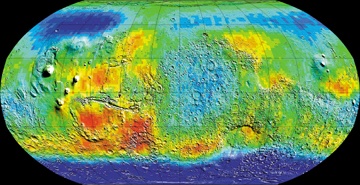
Geotimes Home | AGI Home | Information Services | Geoscience Education | Public Policy | Programs | Publications | Careers

 After clicking to
life the Mars Odyssey spacecraft’s gamma ray and neutron spectrometers in
February, scientists became giddy with excitement. The measurements show an abundant
amount of hydrogen, evidence of ice-rich soil, just beneath the surface of Mars’
southern polar region — enough water locked in ice to fill Lake Michigan
twice over (Geotimes, April 2002).
After clicking to
life the Mars Odyssey spacecraft’s gamma ray and neutron spectrometers in
February, scientists became giddy with excitement. The measurements show an abundant
amount of hydrogen, evidence of ice-rich soil, just beneath the surface of Mars’
southern polar region — enough water locked in ice to fill Lake Michigan
twice over (Geotimes, April 2002).  |
Geotimes Home | AGI Home | Information Services | Geoscience Education | Public Policy | Programs | Publications | Careers |